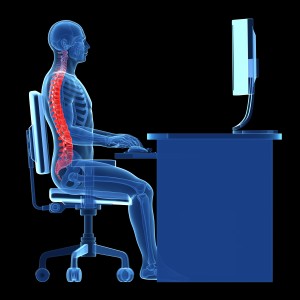Seven Ways to Avoid Computer Vision Syndrome
-

It might sound like something out of a sci-fi movie, but computer vision syndrome (CVS) is a reality in today’s digital world. Also referred to as digital eye strain, computer vision syndrome is caused by overuse of devices with digital screens such as computers, tablets and cellphones. These days it’s not uncommon for people to spend 15 hours or more staring at one screen or another, which takes an obvious toll on eye function and health. Symptoms include eyestrain, blurred vision, dry eyes, headaches and/or neck and shoulder pain. More often than not, CVS is a temporary condition that improves once screen use is discontinued. However, in some cases the symptoms can linger and/or worsen if left unchecked.
Here are seven tips to help avoid computer vision syndrome:
-
1. Take a Break

It’s very easy to sit at your desk and stare at your computer screen all day long, but if you take regular breaks you’ll reduce your risk of computer vision syndrome as well as other health issues associated with sedentary living, like heart disease.
The American Optometric Association recommends a 15-minute break from your computer after two hours of continued use. Additionally, every 20 minutes of computer use you should spend 20 seconds staring into the distance.
-
2. Blink

It might seem silly to suggest managing something that is involuntary, but it’s important to be conscious of your blinking with prolonged use of digital screens. Intense focus can slow blinking which can lead to dry eye, a particularly common symptom of CVS. Frequent blinking helps to keep the eyes moist.
-
3. Say “No” to Glare

Pay attention to the lighting around your computer monitor. If an overhead light, desk lamp or even a window is casting glare on your screen, it could put even more strain on your eyes. If your lights are too bright, consider using a lower wattage bulb or installing a dimmer switch. Adjust your blinds throughout the day to reduce the amount of glare-inducing natural light.
In addition, consider using an anti-glare screen filter that limits the amount of light that can be reflected from your computer screen.
-
4. Adjust the Settings

As you might expect, factory settings are not customized to your liking. As such, they might be causing you unnecessary eye strain or discomfort that can foster CVS. Adjust the brightness, contrast and even font size if the factory settings are causing you problems.
-
5. Wear the Glasses

If you require reading glasses, make sure to always use them when working on a computer, tablet or cellphone. People who already suffer from a vision condition are more susceptible to computer vision syndrome. But sometimes it’s easier to strain to read that last text rather than hunt for your reading glasses. Don’t fall prey to this trap. If you require reading glasses, use them.
-
6. Adjust your Seat

Posture and seating position when working on a computer is incredibly important when it comes to CVS. It might seem like nitpicking, but pay attention to the recommended viewing angle and distance of 15 to 20 degrees below eye level and 20 to 28 inches away. The idea is to avoid straining your eyes or neck to see the screen by positioning it at the perfect viewing location.
-
7. Position Your Reference Materials

If you are working off of reference materials, don’t simply lay them on the desk next to the keyboard. This requires constant twisting of the neck and change of focus to look up and down repeatedly. Instead, set up a document stand adjacent to your monitor so that any reference materials are easily viewable with limited eye or neck strain.



